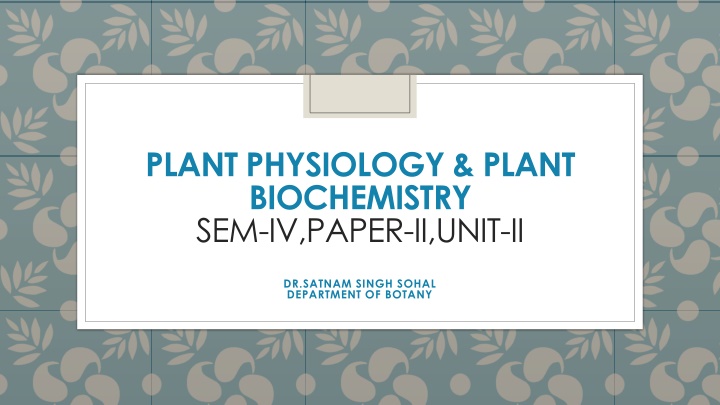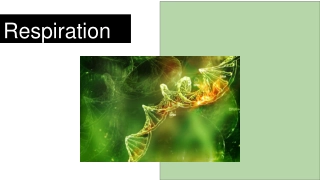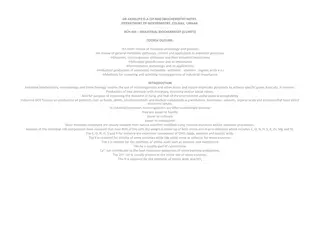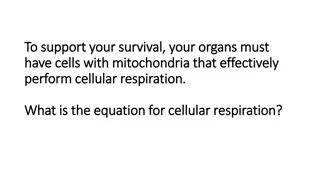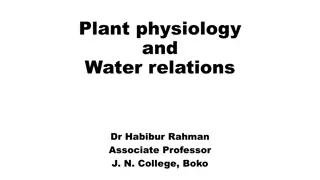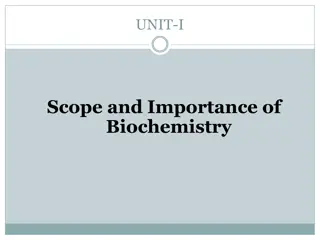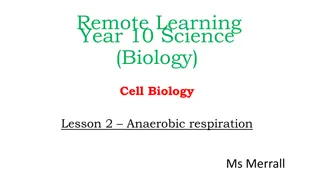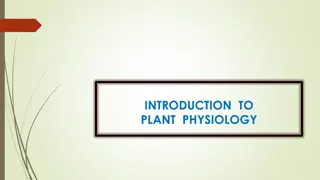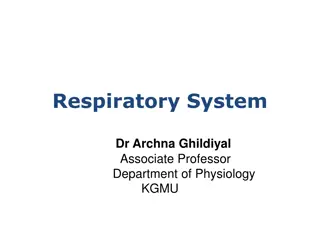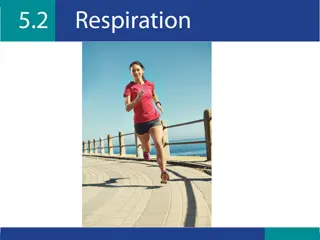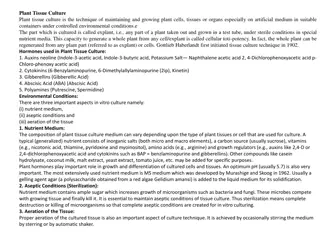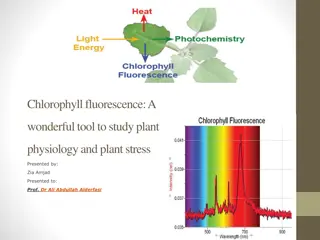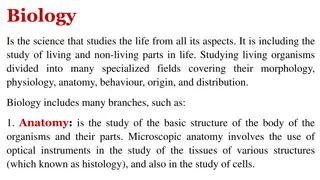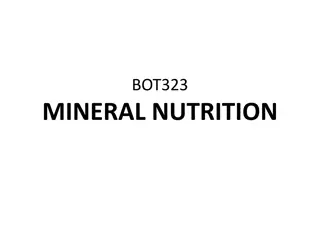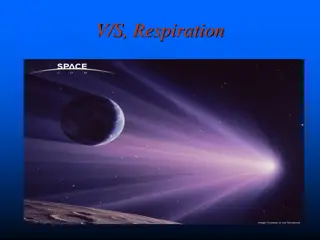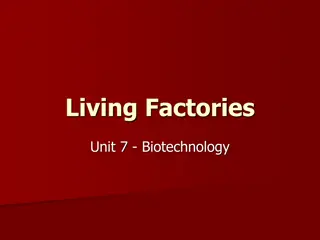Plant Physiology & Biochemistry: Respiration and Photorespiration
In plant physiology and biochemistry, topics like aerobic respiration, photorespiration, and vernalization mechanisms are explored. Aerobic respiration is a process where organisms use oxygen to convert fuel into energy. Differences between aerobic and anaerobic respiration, the role of Phytochrome in flowering, and mechanisms of vernalization are discussed in detail.
Download Presentation

Please find below an Image/Link to download the presentation.
The content on the website is provided AS IS for your information and personal use only. It may not be sold, licensed, or shared on other websites without obtaining consent from the author.If you encounter any issues during the download, it is possible that the publisher has removed the file from their server.
You are allowed to download the files provided on this website for personal or commercial use, subject to the condition that they are used lawfully. All files are the property of their respective owners.
The content on the website is provided AS IS for your information and personal use only. It may not be sold, licensed, or shared on other websites without obtaining consent from the author.
E N D
Presentation Transcript
PLANT PHYSIOLOGY & PLANT BIOCHEMISTRY SEM-IV,PAPER-II,UNIT-II DR.SATNAM SINGH SOHAL DEPARTMENT OF BOTANY
TOPICS Respiration-Aerobic-Glycolysis,TCA cycle,ETS & energetics of respiration,Anaerobic respiration Photorespiration Photoperiodism-Phytochrome,Response & vernalization with reference to flowering in higher plants,Physico chemical properties of Phytochrome,Pr-Pfr interconversion,role of Phytochrome in flowering of SDP & LDP. Vernalization-mechanisms & applications.
Aerobic respiration Definition Aerobic respiration is the process by which organisms use oxygen to turn fuel, such as fats and sugars, into chemical energy. In contrast, anaerobic respiration does not use oxygen. Respiration is used by all cells to turn fuel into energy that can be used to power cellular processes. The product of respiration is a molecule called adenosine triphosphate (ATP), which uses the energy stored in its phosphate bonds to power chemical reactions. It is often referred to as the currency of the cell. Aerobic respiration is much more efficient, and produces ATP much more quickly, than anaerobic respiration. This is because oxygen is an excellent electron acceptor for the chemical reactions involved in generating ATP.
Aerobic vs Anaerobic Similarities Both aerobic and anaerobic respiration are methods of generating energy. They also both start in the same way, with the process of glycolysis. Glycolysis literally means sugar splitting, and involves breaking a sugar molecule down into two smaller molecules. In the process of glycolysis, two ATP molecules are consumed and four are produced. This results in a net gain of two ATP molecules produced for every sugar molecule broken down through glycolysis. This is where the similarities between aerobic and anaerobic respiration end. In cells that have oxygen and aerobic respiration can proceed, a sugar molecule is broken down into two molecules of pyruvate. In cells that do not have oxygen, the sugar molecule is broken down into other forms, such as lactate.
Differences After glycolysis, different respiration chemistries can take a few different paths: Cells using aerobic respiration continue their electron transfer chain in a highly efficient process that ends up yielding 38 molecules of ATP from every sugar molecule. Cells that are deprived of oxygen but do not normally use anaerobic respiration, like our own muscle cells, may leave the end products of glycolysis sitting around, obtaining only two ATP per sugar molecule they split. This is an inefficient method of obtaining energy by respiration.
After glycolysis, cells that do not use oxygen for respiration, but proceed to an electron transport train may use a different electron acceptor, such as sulfate or nitrate, to drive their reaction forward. These processes represent a type of anaerobic respiration called fermentation. Some types of fermentation reactions produce alcohol and carbon dioxide. This is how alcoholic drinks and bread are made.
Aerobic respiration, on the other hand, sends the pyruvate leftover from glycolysis down a very different chemical path, the steps of which are discussed in detail below. Steps of Aerobic Respiration Overall Equation The equation for aerobic respiration describes the reactants and products of all of its steps, including glycolysis. That equation is: 1 glucose + 6 O2 6 CO2+ 6 H2O + 38 ATP In summary, 1 molecule of six-carbon glucose and 6 molecules of oxygen are converted into 6 molecules of carbon dioxide, 6 molecules of water, and 38 molecules of ATP. The reactions of aerobic respiration can be broken down into four stages, described below.
Glycolysis Glycolysis is the first stage of aerobic respiration and occurs in the cytoplasm of the cell. It involves the splitting of 1 six-carbon sugar molecule into 2 three-carbon pyruvate molecules. This process creates two ATP molecules. The overall equation is as follows: C6H12O6 + 2 ADP + 2 PI + 2 NAD+ 2 Pyruvate + 2 ATP + 2 NADH + 2 H+ + 2 H2O This process reduces the co-factor NAD+ to NADH. This is important, as later in the process of cellular respiration, NADH will power the formation of much more ATP through the mitochondria s electron transport chain. In the next stage, pyruvate is processed to turn it into fuel for the citric acid cycle, using the process of oxidative decarboxylation.
Oxidative decarboxylation of pyruvate 2 (Pyruvate + Coenzyme A + NAD+ Acetyl CoA + CO2 + NADH) Oxidative decarboxylation, sometimes referred to as the link reaction or the transition reaction, is the link between glycolysis and the citric acid cycle. Pyruvate is transfered into the mitochondrial matrix via a protein known as pyruvate translocase. Here, the pyruvate is combined with Coenzyme A to release a carbon dioxide molecule and form acetyl-CoA. This transition reaction is important because acetyl-CoA is an ideal fuel for the citric acid cycle, which can in turn power the process of oxidative phosphorylation in the mitochondria, which produces huge amounts of ATP. More NADH is also created in this reaction. This means more fuel to create more ATP later in the process of cellular respiration.
What is respiration. Explain two types you have studied.
The process of respiration in plants involves using the sugars produced during photosynthesis plus oxygen to produce energy for plant growth. In many ways, respiration is the opposite of photosynthesis. In the natural environment, plants produce their own food to survive. They use the carbon dioxide (CO2) from the environment to produce sugars and oxygen (O2), which can later be utilized as a source of energy. While photosynthesis takes place in the leaves and stems only, respiration occurs in the leaves, stems and roots of the plant. The process of respiration is represented as follows: C6H12O6+ 6O2 6CO2+ 6H2O + 32 ATP (energy)
Respiration takes place in the mitochondria of the cell in the presence of oxygen, which is called "aerobic respiration". In plants, there are two types of respiration: dark respiration and photo respiration. The first kind occurs in the presence or absence of light, while the second occurs exclusively in the presence of light.
Anaerobic respiration Anaerobic respiration takes place in absence of oxygen. When no oxygen is present, plants can temporarily use anaerobic respiration to create energy. It is not as efficient, since the glucose molecule does not break down completely, but rather changes into ethyl alcohol and carbon dioxide and creates only two molecules of ATP, or adenosine triphosphate. ATP is a means of storing energy in the form of sugars at the cellular level. Plants cannot keep up the anaerobic respiration process for long, only a few days at most.
The types of anaerobic respiration are as varied as its electron acceptors. Important types of anaerobic respiration include: Lactic acid fermentation In this type of anaerobic respiration, glucose is split into two molecules of lactic acid to produce two ATP. Alcoholic fermentation In this type of anaerobic respiration, glucose is split into ethanol, or ethyl alcohol. This process also produces two ATP per sugar molecule. C6H12O6(glucose) + 2 ADP + 2 phosphate 2 C2H5OH (ethanol) + 2 CO2+ 2 ATP Other types of fermentation Other types of fermentation are performed by some bacteria. These include prop ionic acid fermentation, butyric acid fermentation etc.
Discuss in detail Glycolysis Glycolysis is a part of cellular respiration.It is a series of reactions that constitute the first phase of most carbohydrate catabolism, catabolism meaning the breaking down of larger molecules into smaller ones. The word glycolysis is means the breakdown of sugars. Glycolysis breaks down glucose and forms pyruvate and two molecules of ATP. The pyruvate is the end product of glycolysis and can be used in either anaerobic respiration if no oxygen is available or in aerobic respiration via the TCA cycle which gives much more usable energy in the form of ATP for the cell.
Phytochrome is a photoreceptor, a pigmentthat plants, and some bacteria and fungi, use to detect light. It is sensitive to light in thered and far-red region of the visible spectrum. Many flowering plants use it to regulate the time of flowering based on the length of day and night (photoperiodism and to set circadian rhythms. It also regulates other responses including the germination of seeds(photoblasty), elongation of seedlings, the size, shape and number of leaves, the synthesis of chlorophyll, and the straightening of the epicotyl or hypocotyl hook of dict seedlings. It is found in the leaves of most plants. Biochemically, phytochrome is a protein consists of two identical chains (A and B). Each chain has a PAS domainand GAF domain. The PAS domain serves as a signal sensor and the GAF domain is responsible for binding to cGMP and also senses light signals. Together, these subunits form the phytochrome region, which regulates physiological changes in plants to changes in red and far red light conditions. In plants, red light changes phytochrome to its biologically active form, while far red light changes the protein to its biologically inactive form.
Vernalization (from Latin vernus, "of the spring") is the induction of a plant's flowering process by exposure to the prolonged cold of winter, or by an artificial equivalent. After vernalization, plants have acquired the ability to flower, but they may require additional seasonal cues or weeks of growth before they will actually flower. Vernalization can also refer to herbal (non-woody) plants requiring a cold dormancy to produce new shoots and leaves.[1] Many plants grown in temperate climates require vernalization and must experience a period of low winter temperature to initiate or accelerate the flowering process. This ensures that reproductive development and seed production occurs in spring and summer, rather than in autumn.[2]The needed cold is often expressed in chill hours. Typical vernalization temperatures are between 0 and 5 degrees Celsius (40 and 50 degrees Fahrenheit)
ETS system During cellular respiration, organic compounds are oxidized to generate usable chemical energy in the form of ATP. The respiratory electron transport chain (ETC) of mitochondria is at the center of this process. Its core consists of four oxidoreductase complexes, the NADH dehydrogenase (complex I), the succinate dehydrogenase (complex II), the cytochrome c reductase (complex III) and the cytochrome c oxidase (complex IV), as well as of two mobile electron transporters, cytochrome c, and the lipid ubiquinone. Overall, electrons are transferred from the coenzymes NADH or FADH2onto molecular oxygen which is reduced to water.
Three of the four oxidoreductase complexes (complexes I, III and IV) couple their electron transfer reactions with proton translocation across the inner mitochondrial membrane. As a result, a proton gradient is formed which can be used by the ATP synthase complex (complex V) for the phosphorylation of ADP. In its classically described form, cellular respiration is based on a linear ETC (from NADH via complexes I, III, and IV to molecular oxygen). However, electrons can enter and leave the ETC at several alternative points. This is especially true for the plant ETC system, which is highly branched. In this review we aim to integrate current knowledge on the ETC system in plants with respect to its components, electron transport pathways and supramolecular structure.
Phytochrome is a photoreceptor, a pigment that plants, and some bacteria and fungi, use to detect light. It is sensitive to light in thered and far-red region of the visible spectrum. Many flowering plants use it to regulate the time of flowering based on the length of day and night (photoperiodism and to set circadian rhythms. It also regulates other responses including the germination of seeds(photoblasty), elongation of seedlings, the size, shape and number of leaves, the synthesis of chlorophyll, and the straightening of the epicotyl or hypocotyl hook of dicot seedlings. It is found in the leaves of most plants.
Biochemically, phytochrome is a protein consists of two identical chains (A and B). Each chain has a PAS(Per-Arnt-Sim) domain and GAF domain. PAS domains are newly recognized signaling domains that are widely distributed in proteins from members of the Archaea and Bacteria and from fungi, plants, insects, and vertebrate. PAS domains are important signaling modules that monitor changes in light, The GAF domain is a type of protein domain that is found in a wide range of proteins from all species. The GAF domain is named after some of the proteins it is found in: cGMP( cyclic Guanosine monophosphate)specific phosphodiesterases
The PAS domain serves as a signal sensor and the GAF domain is responsible for binding to c GMP and also senses light signals. Together, these subunits form the phytochrome region, which regulates physiological changes in plants to changes in red and far red light conditions. In plants, red light changes phytochrome to its biologically active form, while far red light changes the protein to its biologically inactive form.
